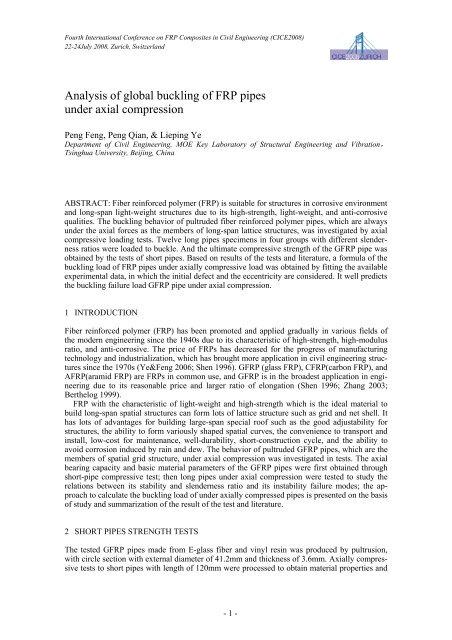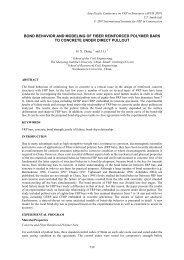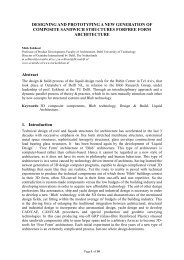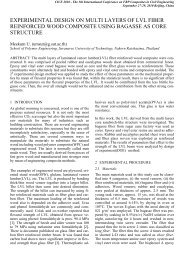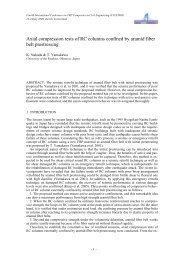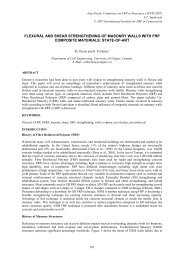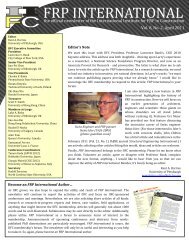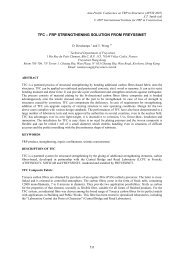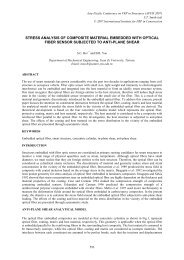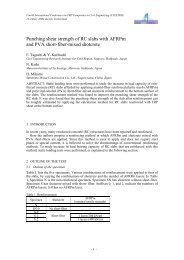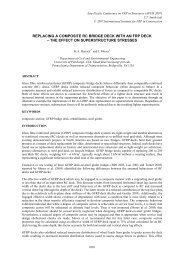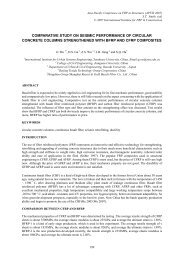Analysis of global buckling of FRP pipes under axial compression
Analysis of global buckling of FRP pipes under axial compression
Analysis of global buckling of FRP pipes under axial compression
Create successful ePaper yourself
Turn your PDF publications into a flip-book with our unique Google optimized e-Paper software.
Fourth International Conference on <strong>FRP</strong> Composites in Civil Engineering (CICE2008)<br />
22-24July 2008, Zurich, Switzerland<br />
<strong>Analysis</strong> <strong>of</strong> <strong>global</strong> <strong>buckling</strong> <strong>of</strong> <strong>FRP</strong> <strong>pipes</strong><br />
<strong>under</strong> <strong>axial</strong> <strong>compression</strong><br />
Peng Feng, Peng Qian, & Lieping Ye<br />
Department <strong>of</strong> Civil Engineering, MOE Key Laboratory <strong>of</strong> Structural Engineering and Vibration,<br />
Tsinghua University, Beijing, China<br />
ABSTRACT: Fiber reinforced polymer (<strong>FRP</strong>) is suitable for structures in corrosive environment<br />
and long-span light-weight structures due to its high-strength, light-weight, and anti-corrosive<br />
qualities. The <strong>buckling</strong> behavior <strong>of</strong> pultruded fiber reinforced polymer <strong>pipes</strong>, which are always<br />
<strong>under</strong> the <strong>axial</strong> forces as the members <strong>of</strong> long-span lattice structures, was investigated by <strong>axial</strong><br />
compressive loading tests. Twelve long <strong>pipes</strong> specimens in four groups with different slenderness<br />
ratios were loaded to buckle. And the ultimate compressive strength <strong>of</strong> the G<strong>FRP</strong> pipe was<br />
obtained by the tests <strong>of</strong> short <strong>pipes</strong>. Based on results <strong>of</strong> the tests and literature, a formula <strong>of</strong> the<br />
<strong>buckling</strong> load <strong>of</strong> <strong>FRP</strong> <strong>pipes</strong> <strong>under</strong> <strong>axial</strong>ly compressive load was obtained by fitting the available<br />
experimental data, in which the initial defect and the eccentricity are considered. It well predicts<br />
the <strong>buckling</strong> failure load G<strong>FRP</strong> pipe <strong>under</strong> <strong>axial</strong> <strong>compression</strong>.<br />
1 INTRODUCTION<br />
Fiber reinforced polymer (<strong>FRP</strong>) has been promoted and applied gradually in various fields <strong>of</strong><br />
the modern engineering since the 1940s due to its characteristic <strong>of</strong> high-strength, high-modulus<br />
ratio, and anti-corrosive. The price <strong>of</strong> <strong>FRP</strong>s has decreased for the progress <strong>of</strong> manufacturing<br />
technology and industrialization, which has brought more application in civil engineering structures<br />
since the 1970s (Ye&Feng 2006; Shen 1996). G<strong>FRP</strong> (glass <strong>FRP</strong>), C<strong>FRP</strong>(carbon <strong>FRP</strong>), and<br />
A<strong>FRP</strong>(aramid <strong>FRP</strong>) are <strong>FRP</strong>s in common use, and G<strong>FRP</strong> is in the broadest application in engineering<br />
due to its reasonable price and larger ratio <strong>of</strong> elongation (Shen 1996; Zhang 2003;<br />
Berthelog 1999).<br />
<strong>FRP</strong> with the characteristic <strong>of</strong> light-weight and high-strength which is the ideal material to<br />
build long-span spatial structures can form lots <strong>of</strong> lattice structure such as grid and net shell. It<br />
has lots <strong>of</strong> advantages for building large-span special ro<strong>of</strong> such as the good adjustability for<br />
structures, the ability to form variously shaped spatial curves, the convenience to transport and<br />
install, low-cost for maintenance, well-durability, short-construction cycle, and the ability to<br />
avoid corrosion induced by rain and dew. The behavior <strong>of</strong> pultruded G<strong>FRP</strong> <strong>pipes</strong>, which are the<br />
members <strong>of</strong> spatial grid structure, <strong>under</strong> <strong>axial</strong> <strong>compression</strong> was investigated in tests. The <strong>axial</strong><br />
bearing capacity and basic material parameters <strong>of</strong> the G<strong>FRP</strong> <strong>pipes</strong> were first obtained through<br />
short-pipe compressive test; then long <strong>pipes</strong> <strong>under</strong> <strong>axial</strong> <strong>compression</strong> were tested to study the<br />
relations between its stability and slenderness ratio and its instability failure modes; the approach<br />
to calculate the <strong>buckling</strong> load <strong>of</strong> <strong>under</strong> <strong>axial</strong>ly compressed <strong>pipes</strong> is presented on the basis<br />
<strong>of</strong> study and summarization <strong>of</strong> the result <strong>of</strong> the test and literature.<br />
2 SHORT PIPES STRENGTH TESTS<br />
The tested G<strong>FRP</strong> <strong>pipes</strong> made from E-glass fiber and vinyl resin was produced by pultrusion,<br />
with circle section with external diameter <strong>of</strong> 41.2mm and thickness <strong>of</strong> 3.6mm. Axially compressive<br />
tests to short <strong>pipes</strong> with length <strong>of</strong> 120mm were processed to obtain material properties and<br />
- 1 -
the <strong>axial</strong>ly compressive strength. Five specimens were taken from different batches <strong>of</strong> the<br />
G<strong>FRP</strong> pipe products. The G<strong>FRP</strong> <strong>pipes</strong> were exerted <strong>axial</strong> pressure after alignment on compressive<br />
test machine. Strain gauges were placed in the opposed places <strong>of</strong> the central section <strong>of</strong> the<br />
outer-surface <strong>of</strong> the <strong>pipes</strong> to measure the <strong>axial</strong> strain and transverse strain <strong>of</strong> the G<strong>FRP</strong> <strong>pipes</strong>.<br />
Table 1 Experimental result <strong>of</strong> short G<strong>FRP</strong> <strong>pipes</strong> <strong>under</strong> <strong>axial</strong> <strong>compression</strong><br />
No.<br />
Failure<br />
load<br />
P u (kN)<br />
Longitudinal<br />
failure strains<br />
ε u,L (με)<br />
Transverse<br />
failure strains<br />
ε u,T (με)<br />
Failure<br />
stress<br />
σ u,L (MPa)<br />
Longitudinal<br />
elastic modulus<br />
E L (MPa)<br />
Poisson's<br />
ratio<br />
ν LT<br />
SCGP-1 92.0 7819 2936 216.4 27682 0.39<br />
SCGP-2 71.0 6192 2178 166.8 27054 0.35<br />
SCGP-3 87.0 7284 3463 204.4 28347 0.38<br />
SCGP-4 73.0 6331 1709 171.6 21626 0.27<br />
SCGP-5 87.0 7820 2480 204.4 26404 0.35<br />
Average 84.3 7279 2764 198.4 27372 0.37<br />
* SCGP-4 is discarded because it was crushed <strong>under</strong> eccentric load for sliding equipment.<br />
The relations <strong>of</strong> the load and strain measured during the progression <strong>of</strong> the tests were linear in<br />
the gross. A sound <strong>of</strong> “pipa” was caught when the longitudinal strain reached to 5000με, and the<br />
sound continued to the destruction <strong>of</strong> the pipe. The longitudinal strain <strong>of</strong> the pipe reached to<br />
6200με to 7800με when the specimens were destructed which was a sudden course comparatively<br />
and accompanied by huge noises. Finally, a number <strong>of</strong> longitudinal cracks appeared on<br />
G<strong>FRP</strong> <strong>pipes</strong>. The experimental results were presented in Table.1, in which the mechanical properties<br />
were taken from the average value <strong>of</strong> the <strong>pipes</strong>.<br />
3 LONG PIPES STABILITY TESTS<br />
Four groups <strong>of</strong> G<strong>FRP</strong> <strong>pipes</strong> with the different slenderness ratios and the same cross-section as<br />
the tested short <strong>pipes</strong>, each group including three same specimens, were tested to investigate the<br />
stability <strong>of</strong> G<strong>FRP</strong> <strong>pipes</strong> <strong>under</strong> <strong>axial</strong> <strong>compression</strong>. Their parameters are shown in Table 2. The<br />
G<strong>FRP</strong> <strong>pipes</strong> were placed in the fixture (the effective calculated length <strong>of</strong> element includes the<br />
height <strong>of</strong> the fixture with two ends), then were exerted longitudinal pressure after alignment.<br />
The loading was controlled by force. The longitudinal strain and lateral displacements <strong>of</strong> the<br />
middle section, and vertical displacement at the load end were measured, the testing setup and<br />
the placement <strong>of</strong> the strain gauge and displacement meters as shown in Figure 1 and Figure 2.<br />
Table 2 Geometrical parameters <strong>of</strong> tested long G<strong>FRP</strong> <strong>pipes</strong><br />
No. Length l(mm) Slenderness ratio λ Support condition<br />
LCGP35 700 35 Fixed ends<br />
LCGP45 1000 45 Fixed ends<br />
LCGP55 1300 55 Fixed ends<br />
LCGP90 1500 90 Fixed bottom / hinged top<br />
*LCGP35:Long Compressive G<strong>FRP</strong> Pipes 35 (slenderness ratio)<br />
The tested specimens had the similar phenomenon in the gross: little deformation at the beginning<br />
<strong>of</strong> the loading; when it closed to <strong>buckling</strong> load, the lateral displacement in the central<br />
part <strong>of</strong> the bar increased rapidly; then the <strong>buckling</strong> <strong>of</strong> the whole element occurred. The lateral<br />
deformation <strong>of</strong> the <strong>pipes</strong> was in the shape <strong>of</strong> half-wave sine curve when it was instability. All<br />
belong to the <strong>global</strong> <strong>buckling</strong> failure.<br />
Figure 3 shows the <strong>axial</strong> force-middle-point lateral displacement curves <strong>of</strong> all groups <strong>of</strong><br />
specimens. It can been seen in the curves that the existing <strong>of</strong> the initial defect leads the lateral<br />
displacement increasing with the load raising, and there appears a distinctive inflexion with the<br />
<strong>buckling</strong>, since then the vertical load nearly become invariable but the lateral deformation increases<br />
rapidly until the failure <strong>of</strong> the sample. Figure.3(a) shows the <strong>axial</strong> force-lateral displacement<br />
curves <strong>of</strong> LCGP35 group. As the existence <strong>of</strong> a small gap in the support bracket,<br />
- 2 -
there is an inflexion on the curves at the beginning <strong>of</strong> the loading. The lateral displacement <strong>of</strong><br />
LCGP35-1 and LCGP35-3 increased rapidly after instability, and the specimens reached to the<br />
ultimate <strong>compression</strong> and failure occurred when the lateral displacement reached to 10mm; the<br />
LCGP35-2 appeared failure soon after instability as the stress concentration near the end, and<br />
the lateral displacement was only 4mm at this point. Figure 5(b) shows the <strong>axial</strong> force-lateral<br />
displacement curves <strong>of</strong> LCGP45 group. The lateral stiffness <strong>of</strong> LCGP45-3 had an abrupt change<br />
because a contact slip happened when the load reached to 10kN. The stiffness <strong>of</strong> three specimens<br />
kept homologous until the instability <strong>of</strong> the samples. Among them, the <strong>buckling</strong> load <strong>of</strong><br />
LCGP45-1 was comparatively lower, 44kN, as the inadequately end constraint caused by little<br />
rotation <strong>of</strong> the fixture, but the <strong>buckling</strong> loads <strong>of</strong> the other two were around 60kN. Figure 5(c)<br />
shows the <strong>axial</strong> force-lateral displacement curves <strong>of</strong> LCGP55 group. The lateral stiffness <strong>of</strong><br />
LCGP55-3 increased slowly before its <strong>buckling</strong>, and it had the largest <strong>buckling</strong> load in the three<br />
specimens, which proved that its initial defect is comparatively small. Obviously, the initial defect<br />
is a very important factor to influence the <strong>buckling</strong> load <strong>of</strong> elements. Figure 5(d) shows the<br />
<strong>axial</strong> force-lateral displacement curves <strong>of</strong> LCGP90 group. When LCGP90-1 was loaded to 8kN,<br />
the ends <strong>of</strong> the bar were pressure-compacted partially, so its stiffness bounced suddenly, that is<br />
its lateral displacement kept constant while the <strong>axial</strong> load increased. To 13kN, the lateral displacement<br />
increased suddenly, it went to the condition <strong>of</strong> instability quickly. Compared with<br />
LCGP90-1, the stiffness <strong>of</strong> the other two specimens changed little during the loading.<br />
Jack<br />
l/2<br />
Displacement<br />
Meter<br />
Strain<br />
Gauge<br />
l<br />
G<strong>FRP</strong><br />
Pipe<br />
l/2<br />
Strain<br />
Gauges<br />
S3<br />
S 2<br />
G<strong>FRP</strong><br />
Pipe<br />
S 1<br />
Fixture<br />
Support<br />
Displacement<br />
Meters<br />
S 4<br />
Strain<br />
Gauges<br />
Figure 1. Testing setup for long G<strong>FRP</strong> <strong>pipes</strong> <strong>under</strong> <strong>axial</strong> <strong>compression</strong><br />
Figure 2. Location <strong>of</strong> measured<br />
points in the middle section<br />
4 OVERALL STABILITY ANALYSIS OF G<strong>FRP</strong> PIPES<br />
There are a few researches on the overall stability <strong>of</strong> G<strong>FRP</strong> members published. Goodman et al<br />
(1969) tested three boron/epoxy <strong>FRP</strong> <strong>pipes</strong> with the radius <strong>of</strong> 81mm and the thickness <strong>of</strong><br />
0.53mm <strong>under</strong> <strong>axial</strong> <strong>compression</strong>. The ratio between the experimental results and the calculated<br />
result by the Euler formula, Eq.(1), are 0.81, 0.97 and 1.06 respectively. The elastic modulus E<br />
was determined by experiment <strong>of</strong> short column <strong>under</strong> <strong>axial</strong> <strong>compression</strong>.<br />
2<br />
π EI<br />
PE<br />
= (1)<br />
2<br />
L<br />
Hewson et al (1978) investigated the flexural <strong>buckling</strong>, torsional <strong>buckling</strong> and flexural torsional<br />
coupling <strong>buckling</strong> <strong>of</strong> pultruded C-shaped G<strong>FRP</strong> members <strong>under</strong> <strong>axial</strong> <strong>compression</strong>. The flexural<br />
<strong>buckling</strong> load <strong>of</strong> the components was calculated by Euler formula, but E and G were replaced<br />
- 3 -
y longitudinal elastic modulus EL determined by bending test and longitudinal-transversal<br />
shear modulus GLT determined through torsion test. The error <strong>of</strong> the <strong>buckling</strong> loads <strong>of</strong> experiment<br />
to the theoretical result was from 5% to 11%. Lee and Hewson (1978) found that the shear<br />
deformation must be considered as EL/GLT was comparatively large based on the study on the<br />
<strong>buckling</strong> properties <strong>of</strong> the C<strong>FRP</strong> C-shaped members <strong>under</strong> <strong>axial</strong> <strong>compression</strong> in 1979. They<br />
suggested that the <strong>buckling</strong> load <strong>of</strong> slender <strong>FRP</strong> component should be calculated by the modified<br />
Euler formula as<br />
PE<br />
P = t<br />
1 + ( PE / KAG<br />
s g lt)<br />
(2)<br />
where P<br />
E<br />
is the Euler <strong>buckling</strong> load determined by Eq.(1), A<br />
g<br />
is the net section area <strong>of</strong> the<br />
<strong>FRP</strong> member, and K<br />
s<br />
is the shear parameters related to the shape <strong>of</strong> the cross section, for rectangular<br />
section and circular section which is 0.83 and 0.9 respectively. Zureick et al<br />
(1992;1997) had an experimental study on G<strong>FRP</strong> square <strong>pipes</strong> <strong>under</strong> <strong>axial</strong> <strong>compression</strong>. The<br />
section <strong>of</strong> the specimens was a 76.2mm×76.2mm square with the wall <strong>of</strong> thickness <strong>of</strong> 6.3mm.<br />
Their slenderness ratio were 89,87,76, and 66 respectively. It was found that the <strong>buckling</strong> load<br />
<strong>of</strong> the experimental results corresponded well with the results <strong>of</strong> the modified Euler formula,<br />
Eq.(2). Zureick and Scott (1997) conducted experimental studies on two types <strong>of</strong> wide flange H-<br />
shaped section and 2 types <strong>of</strong> box-section G<strong>FRP</strong> components <strong>under</strong> <strong>axial</strong> <strong>compression</strong>. Each<br />
type <strong>of</strong> section included 6 specimens, totally 24 specimens. Their effective slenderness ratio<br />
were from 36 to 103. The ratios between the experimental results and the calculated results by<br />
Eq.(1) and Eq.(2) are 0.85-0.97 and 0.88-1.01 respectively. Hence, the reduction factor <strong>of</strong> 0.85<br />
on the basis <strong>of</strong> the <strong>buckling</strong> load by Eq.(2) was proposed for design <strong>of</strong> G<strong>FRP</strong> component <strong>under</strong><br />
<strong>axial</strong> <strong>compression</strong>. Barbero et al (1993; 1994) studied the <strong>buckling</strong> properties <strong>of</strong> the <strong>FRP</strong> components<br />
<strong>under</strong> the coupling influence <strong>of</strong> <strong>global</strong> <strong>buckling</strong> and local <strong>buckling</strong>.<br />
80<br />
80<br />
60<br />
60<br />
P (kN)<br />
40<br />
20<br />
LCGP35-1<br />
LCGP35-2<br />
LCGP35-3<br />
P (kN)<br />
40<br />
20<br />
LCGP45-1<br />
LCGP45-2<br />
LCGP45-3<br />
0<br />
(a) LCGP35<br />
30<br />
0.0 2.0 4.0 6.0 8.0 10.0<br />
Δ (mm)<br />
0<br />
(b) LCGP45<br />
20<br />
0.0 5.0 10.0 15.0 20.0<br />
Δ (mm)<br />
25<br />
20<br />
15<br />
P (kN)<br />
15<br />
10<br />
5<br />
LCGP55-1<br />
LCGP55-2<br />
LCGP55-3<br />
P (kN)<br />
10<br />
5<br />
LCGP90-1<br />
LCGP90-2<br />
LCGP90-3<br />
0<br />
0 5 10 15 20<br />
Δ (mm)<br />
(c) LCGP55<br />
(d) LCGP90<br />
Figure 3 Axial force-lateral displacement curves <strong>of</strong> tested <strong>pipes</strong><br />
0<br />
0 5 10 15 20<br />
Δ (mm)<br />
It can be seen that the influence <strong>of</strong> initial geometric defect and initial eccentricity were not<br />
considered in the above formulas <strong>of</strong> the <strong>buckling</strong> load <strong>of</strong> <strong>FRP</strong> members <strong>under</strong> <strong>axial</strong> <strong>compression</strong>.<br />
But it is certain that the initial geometric defect and initial eccentricity exist in real struc-<br />
- 4 -
tures for different reasons. Therefore, a modified Perry formula (Chen 2003) to calculate the<br />
<strong>buckling</strong> load <strong>of</strong> the G<strong>FRP</strong> member is suggested based on fitting tested members to obtain the<br />
equivalently relatively initial bending ε<br />
0<br />
. The formula is<br />
1 2 2 2 2<br />
ϕ = [(1 + ε<br />
2<br />
0<br />
+ λ ) − (1 + ε0<br />
+ λ ) − 4 λ ]<br />
(3)<br />
2λ<br />
P<br />
er<br />
= ϕ f A<br />
L<br />
where the ϕ is stability factor, P<br />
er<br />
is the <strong>buckling</strong> load, f<br />
L<br />
is the longitudinal compressive<br />
strength, which should be 198.4MPa for G<strong>FRP</strong> <strong>pipes</strong> used according to the experimental result<br />
in Table 1, and λ is the regularized slenderness ratio, which is :<br />
λ<br />
λ =<br />
π<br />
μL<br />
λ =<br />
r<br />
f<br />
E<br />
L<br />
L<br />
I<br />
r = (4)<br />
A<br />
where E<br />
L<br />
is the longitudinal elastic modulus <strong>of</strong> the G<strong>FRP</strong> component, I is the sectional<br />
moment <strong>of</strong> inertia, A is the section area <strong>of</strong> components, r is the sectional gyration radius,<br />
and μ is the effective length coefficient <strong>of</strong> the component.<br />
Refer to The Technical Code <strong>of</strong> Cold-Formed Thin-Wall Steel Structures (2001) , the expression<br />
<strong>of</strong> initially relative eccentric ratio is<br />
2<br />
ε<br />
0<br />
= a+<br />
bλ<br />
Fitting the data in this test and literature (Zureick 1992; 1997), 32 specimens totally, using the<br />
least square method, the result <strong>of</strong> a is -0.04, b is 0.09, substituting to Eq. (3) and Eq.(5), then<br />
1 2 2 2 2<br />
ϕ = [(0.96 + 1.09 λ ) − (0.96 + 1.09 λ ) − 4 λ ]<br />
(6)<br />
2<br />
2λ<br />
As the consequence, Eq.(6) has a better corresponding with the test data than Eq.(2). The calculated<br />
results <strong>of</strong> Eq.(2) and Eq.(6) and the test data are illustrated in Figure 4. It can be seen<br />
that Eq.(2) may over-estimated the <strong>buckling</strong> load <strong>of</strong> the members with the smaller slenderness<br />
ratio so as to acquired a unsafe design. Therefore, Eq.(6) should be used to determined the stability<br />
factor <strong>of</strong> the <strong>FRP</strong> members. If the calculated result <strong>of</strong> ϕ is greater than 1.0, it should be<br />
equal to 1.0, which means the pipe may be crushed before <strong>buckling</strong>.<br />
(5)<br />
ϕ<br />
1 . 00<br />
0 . 80<br />
0 . 60<br />
0 . 40<br />
○ 41.2 x 3.2<br />
I 102 x 102 x 6.4<br />
I 152 x 152 x 9.5<br />
□ 76 x 76 x 6.4<br />
□ 102 x 102 x 6.4<br />
Eq ( 2) Eular formula<br />
Eq ( 6) Proposed formula<br />
Eq ( 7) Proposed design formula<br />
0 . 20<br />
0 . 00<br />
0 1 2 3 4 5<br />
λ<br />
Figure 4.Stability factor curve <strong>of</strong> <strong>FRP</strong> member <strong>under</strong> <strong>axial</strong> <strong>compression</strong><br />
- 5 -
Eq.(6) is a fitting mean curve based on the tests data. For the practical design, a reduction coefficient<br />
φ<br />
c<br />
should be multiplied on the results <strong>of</strong> Eq.(6), . If the guarantee rate is 97.72%, that<br />
is φ<br />
c<br />
= 1/(Mean + 2i Mean-square Deviation ) , its value can be determined by the tests data, which<br />
is about 0.75. So the following formula for design is proposed,<br />
3 2 2 2 2<br />
ϕ = [(0.96 + 1.09 λ ) − (0.96 + 1.09 λ ) − 4 λ ] ≤ 0.75<br />
(7)<br />
2<br />
8λ<br />
5 CONCLUSIONS<br />
(1) It is shown in the <strong>axial</strong> loading test <strong>of</strong> five short G<strong>FRP</strong> <strong>pipes</strong> that they have the characteristics<br />
<strong>of</strong> linear elastic and brittle failure. And the dispersion <strong>of</strong> the compressive strength <strong>of</strong> G<strong>FRP</strong><br />
is considerable, the maximum variation coefficient reaches 20%, but the dispersion <strong>of</strong> its elastic<br />
constant is smaller relatively as its variation coefficient is within 6%.<br />
(2) Based on the experimental study <strong>of</strong> long G<strong>FRP</strong> <strong>pipes</strong> with the different slenderness ratio, the<br />
relationships <strong>of</strong> <strong>axial</strong> load to lateral displacement, vertical displacement and strain are obtained.<br />
It was found that the <strong>pipes</strong> with smaller slenderness ratio can be compressed to fracture at the<br />
ultimate compressive strain caused by lateral deformation after <strong>buckling</strong>, whereas, the <strong>pipes</strong><br />
with larger slenderness ratio buckle in elastic and fail in oversize deformation.<br />
(3) Based on the test results in this paper and literature, a stability factor formula <strong>of</strong> G<strong>FRP</strong><br />
members <strong>under</strong> <strong>axial</strong> <strong>compression</strong> is presented, in which the initial defect and eccentricity are<br />
considered. And a calculation method for design is proposed.<br />
6 ACKNOWLEDGEMENTS<br />
The authors are grateful to the Natural Science Foundation <strong>of</strong> China for their support to the research<br />
presented here through a national key project (Project No. 50238030).<br />
7 REFERENCE<br />
Barbero, E. J., and Raftoyiannis, I. G. 1993. Euler <strong>buckling</strong> <strong>of</strong> pultruded composite columns. Composite Structures, 1993, 24(2):<br />
139-147.<br />
Barbero, E. J., and Tomblin, J. 1994. A phenomenological design equation for <strong>FRP</strong> columns with interaction between local and<br />
<strong>global</strong> <strong>buckling</strong>. Thin-Walled Structures, 18(2): 117-131.<br />
Berthelot, J-M. 1999. Composite Materials: Mechanical Behavior and Structural <strong>Analysis</strong>, Translated by Cole J M. New York:<br />
Springer-Verlag.<br />
Chen, J. 2003. Stability <strong>of</strong> Steel Structures: Theory and Design. Beijing: Science Press. (In Chinese)<br />
Goodman, J. W., and Gisksman, J. A. 1969. Structural evaluation <strong>of</strong> long boron composite column. Composite Materials: Testing<br />
and Designing, ASTM STP 460: 460-469.<br />
GB50018-2002. 2002. Technical Code <strong>of</strong> Cold-Formed Thin-Wall Steel Structures.<br />
Hewson, P. J. 1978. Buckling <strong>of</strong> pultruded glass fibre-reinforced channel section . Composites, 9(17): 56-60<br />
Lee, D. J., and Hewson, P. J. 1978. The use <strong>of</strong> fiber-reinforced plastics in thin-walled structures. In: Richards T H, Stanley P. eds.<br />
Stability Problems in Engineering Structures and Components. New York: Elsevier Applied Science, 23-55<br />
Shen, G. L. 1996. Composites Mechanics. Beijing: Tsinghua University Press. (In Chinese)<br />
Ye, L. P., and Feng, P. 2006. Applications and development <strong>of</strong> fiber-reinforced polymer in engineering structures. China Civil Engineering<br />
Journal, 39(3): 24-36. (In Chinese)<br />
Zhang, Y. L. 2003. Handbook <strong>of</strong> Advanced Composites Manufacture Technologies. Beijing: China Machine Press. (In Chinese)<br />
Zureick, A., Yoon, S., and Scott, D. 1992. Experimental investigation on concentrically loaded pultruded columns. In: Hamlin P,<br />
Verchery D. eds. Proceedings <strong>of</strong> 2nd International Symposium <strong>of</strong> Textile Composites in Building Construction. Paris, France,<br />
207-215.<br />
Zureick, A., and Scott, D. 1997. Short-term behavior and design <strong>of</strong> fiber-reinforced polymeric slender members <strong>under</strong> <strong>axial</strong> <strong>compression</strong>.<br />
Journal <strong>of</strong> Composites for Construction, 1(4):140-149.<br />
- 6 -


